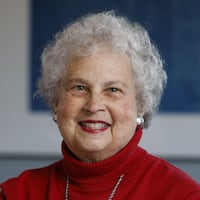“All I know is that they’re changing the words to try to make Scripture more meaningful,” said the Trotwood woman, who, at age 84, has experienced many changes over the years — including the dramatic transition from the all-Latin Mass of her childhood to English.
“For me, whenever there’s a change, it’s a disruption in my thinking and in my prayers, but I look at it as something I need to learn. It’s only difficult in the sense that it’s new.”
That positive but realistic attitude is precisely what those who have been involved with the introduction of the translation of the Mass are hoping to encounter everywhere.
Karen Kane, director of the Worship Office for the Archdiocese of Cincinnati, has been “eating and sleeping” the new Roman Missal for the past couple of years. The Missal is the book used by priests and members of the congregation that contains all the prayers and descriptions of the actions making up the celebration of the Mass.
“What’s about to take place,” she explains, “is that the words we use at Mass will be changed pretty substantially, particularly for the priests and the prayers that they pray.”
Although the spoken and sung responses of the lay people are changing as well, those changes aren’t as dramatic.
The goal, said Kane, is to introduce “a higher and more sacred language” that separates it from everyday conversation and to clarify the connection between the Mass and the Scripture that serves as its foundation.
Some examples?
The word “venerate” will replace the word “honor.”
The word “oblation” will replace the word “offering.”
A “cup” will become a “chalice,” and “The one in being” will become “consubstantial.”
The current changes, Kane said, aren’t nearly as major as the changes that came about in 1963 after Vatican II. Not only was the Latin Mass permitted to be said in the vernacular in order to make it more accessible, but altars were turned around so that the priest faced the people.
“I’ve talked with a lot of people about those changes and the vast majority of people received the changes that Vatican II brought about happily because the liturgy became something they could actively participate in,” said Kane. “It was prayed in a language they understood; they could see what was going on; they were no longer spectators of a ritual the priest was doing. The ritual of the Mass became the work of everyone.”
It’s important to note, Kane said, that the changes taking place this weekend are nothing like those previous changes.
“These changes only affect the words, but do not affect the order of the Mass,” she said.
The project, undertaken in 2000 by the International Commission on English in the Liturgy, involved a series of preliminary editions, with feedback eventually given to the Bishops Committee for Divine Worship in Washington, D.C.
Kane said in preparation for the upcoming changes, there have been countless educational programs for priests, deacons, staffers and the “lay faithful,” as well as chant workshops.
“The formation or education we were hoping to do wasn’t simply on the word changes, but our hope was the programs would help people understand why we do what we do at Mass and help people deepen their understanding and experience of the Mass,” she said.
Among those who have helped to educate their parishioners are John Grusenmeyer and Karla Kosey, Tecumseh High School students and active members of Sacred Heart Catholic Church in New Carlisle.
The teens attended Laudate, a Catholic music retreat, last summer, where they were introduced to the new translation.
“My grandma always used to say that singing was praying twice — using the gifts God has given you at the same time you are talking to God and worshiping Him,” said Grusenmeyer, who explains that because the words had changed, some of the music had to change as well.
Since August, the teens have been helping the members of their church “slowly work toward the new translation” with special emphasis on reaching people their own age.
“It’s a change and may be hard to get used to, but nobody dislikes it,” he said.
The Rev. Michael Pucke of St. Julie Billiart Catholic Church in Hamilton has been reassuring his parishioners about the upcoming changes in a number of ways. He’s been discussing the changes in church for the past few weeks, and has already introduced the music that will now accompany the “Gloria.” A user-friendly booklet has been prepared for parishioners.
“We decided that rather than give everybody everything, we would give people what they need right now and not overwhelm them,” he explains. “It’s something that will help them make this new translation their own.”
Pucke said that because the new translation uses grammar that is more like the Latin than English, it can appear convoluted.
He prefers to call it “transcendent.”
“The change in language,” he said, “can help us have a new perspective on the mystery of God.”
Contact this reporter at (937) 225-2440 or mmoss@DaytonDailyNews.com.
About the Author
